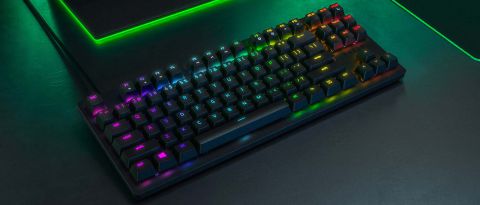Review: Fast & Light Razer Huntsman Tournament Edition
We are witnessing the start of a 2019 boom in sports equipment. Big companies such as Razer & Cooler Master have already been present in this race as well as small but prosperous uprights such as PC Gaming Race and Finalmouse. We saw, however, fewer esports keypads to the point till now. In short, the most recent Razer Huntsman Tournament Edition (TE) looks like a textbook example.
It’s small, practical and easy to replace and its buttons count on the lightest contact. You are expected to skyrocket your mistakes rate per Email since that is the disadvantage of this faster keyboard. Another reason for typing mistakes could be that with each keystroke, Huntsman TE makes you feel lose your grip on the key. If you play matches that benefit, you can help turn your twitches into victories.
Design
Even for a “tenkeyless” claw, the TE Huntsman looks and feels compact. It has just the basics to support its keys and a small outside edge at 1.5 by 14.2 by 5.5 inches~14 cm. (The keyboard’s keyboard is lingo with the number pad lopped off.) There is no unnecessary room for lighting, media buttons or logos. Over the arrow buttons of the keyboard, the company name “Razer” is graved to make it branded.
The compact body is not just for the exhibition: it is designed for tournaments, as the name suggests. It weighs only 1.7 pounds that make it really lightweight keyboard among others. Moreover, the cables are detachable. In the bottom of the board’s back-left corner, the USB Type C port on the keyboard is integrated. The Type C connector has security rails to keep it in place and safe from being yanked off and disconnected. That is obviously important, but it prevents you from using other USB-C cables instead of Razer cabling, and I could see how convenient the easy flexibility of cable substitution is.
Of course, if you don’t like to use it, you will not bring a keyboard anywhere. The Huntsman TE uses the new optical Razer Linear key switch. In a generic sense, optical switches are a special, unusual and mechanical type. Let’s explain that. Let’s explain.
Difference in Optical
Optical keypads trigger inputs with light beams for those who are not aware of them. A key can press through the beam from one hand instead of pushing a button with physical touch. The passing beam complete the loop and indicate the button was pushed. According to Razer, its Linear Optical Switch makes it possible to operate faster, especially when you often press the same key. Razer also says that it reduces long-term wear and tear because each key needs fewer moving components compared to a typical mechanical switch.
We guarantee you the lightest touch of any computer we have ever used is the Huntsman TE. The key operates at only 1 mm depression, from a distance of 3.5 mm. In fact, before the result starts on the screen, it feels like you hardly need to touch a key. It sometimes feels like every thought goes straight to the screen from your brain.
This obviously has consequences for twitchy shooter titles, strategy games and MOBAs in sports-minded keyboards, but it really is valid for every game. I’m not sure my play is faster due to the shallow action.
However, the problem? A keyboard which appears to type on a key tap’s suggestion does not always work for you. The keyboard can be some responsibility outside of the games. It can even be problematic to keep your fingers on the keys. You can go from a hold position to press-key with just a little pressure. It’s as smooth as that.
Certainly some severe competitors who understand their hardware are used to this enhanced spelling error and error propensity. Since Razer Linear keyboard is not the first and only lighter keyboard available in the marketplace. Cherry MX Reds and Razer Yellows are other sensitive linear buttons and make it easy to press incorrect keys. You get familiar with it. However, Razer Linear has brought this feather-light keyboard game to the next level. We are sure players who’ll have Huntsman TE, they will find their flow just like the linear mechanical switches. On the other hand, as a person who plays and writes a lot, the typing aspect of these buttons is a little too finely designed to their tastes.
Synapse Lighting
The Huntsman TE supports Synapse, a configuration software for your company, as with all Razer products. You can customize your key mapping, make macros, and set the RGB lighting on the keyboard with the help of Synapse technology.
The Huntsman TE features an internal memory that can store up to five keyboard profiles in line with the portability component of the keyboard. For a mid-to-high-end board, this is about average. Synapse can store the number of profiles you like on your home PC and synchronize them to as many games and apps as you like.
The illumination on the Huntsman TE is quite subtle. The light you can personalize on a key-by-key basis using the Chroma Studio software of Razer is easy to understand even at the highest level of brightness. It is fairly lightweight, but the look of Razer, a company closely associated with bold PC-hardware lighting, is a bit subdued.
Final Verdict
The Huntsman TE is a certain player in the market. With its $129.99 MSRP many buyers can spend the same money and get a high-end mechanical keyboard that will probably have more ports (like media keys and USB ports) and could be better for daily computing.
Still, the Huntsman TE has something to offer. We can’t guarantee it makes you a better player, but it can emphasize a certain instinctual play style–the type you play as quickly as you can think, and the best keyboarder is the one you just take out of the game. Huntsman TE could be your greatest speed pipe–and victory if you are quick enough in your favorite games to get this kind of telepathic flow.
Read Next: Playstation 5: PS5 Rumors, Price, Release Date, and More




